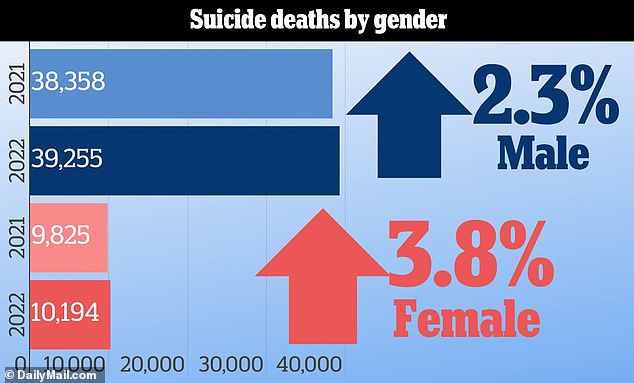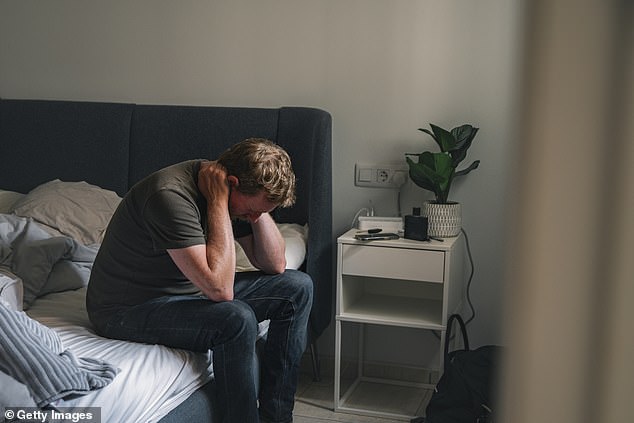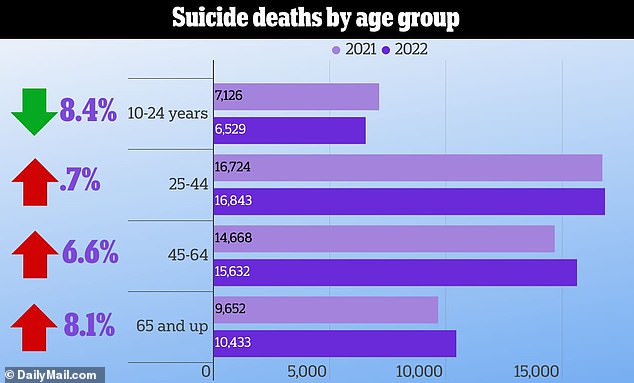America’s $230million ‘lifeline’: Biden announces new funding to address ‘alarming’ suicide rate that is killing 130 Americans a day
The Biden administration has committed more than $230 million in grants to support suicide prevention efforts amid an “unprecedented” mental health crisis in the US.
Suicide is one of the leading causes of preventable deaths in America, especially among children and teens, who make up 15 percent of all suicides in the US.
The grant money will go towards improving the capacity of the suicide prevention hotline, which last year moved from a longer, harder-to-remember telephone number to the three-digit 988 number so that people in crisis can remember it more easily.
The money will also improve access to mental health treatment for marginalized groups, including American Indians living on tribal lands.
Rates of mental illness in the US rose steadily in 2018 before declining slightly just before the Covid pandemic.
In 2021, during the height of the pandemic, with millions of people isolated from activities and treatments for their conditions, the suicide rate began to rise again, with no signs of decline.
After a slight decline in the year leading up to the global pandemic, suicides rebounded in 2021. The total increased by five percent that year.

Although women are less likely than men to commit suicide, they saw a more drastic increase in one year. Suicide statistics show that women are roughly three times more likely to commit suicide, while men are two to four times more likely to die by suicide
Suicide was responsible for 48,183 deaths in 2021, about 132 per day. In 2022, that total was 49,449, which equates to more than 135 deaths per day.
Andrea Palm, the deputy secretary of the Department of Health and Human Services, said, “Our country is facing an unprecedented behavioral health crisis that is impacting people of all ages.
“We have invested in 988 community and school-based care, expanding our healthcare workforce and other critical support. We will continue as long as it is necessary.’
The federal suicide hotline switched last year from its previous phone number — 1-800-273-TALK — to 988. designed to connect callers in crisis directly to first responders within the National Suicide Prevention Lifeline Network.
The idea was to make suicide prevention resources as easily accessible as a 911 call operator. The program received five million crisis calls in its first year, two million more than the average received under the previous phone number.
Of the grant allocation, more than $177 million will go toward supporting mental health staff to respond to calls from local crisis centers and leveraging new technology to improve the ability to respond to local callers across the country.
Another $18.3 million will specifically lend more resources to American Indian and Alaska Native groups, which have the highest suicide rates of any demographic group in the US.
Suicide rates among American Indians and Alaska Natives rose nearly 20 percent between 2015 and 2020 CDC data.
$5 million will give crisis centers the capacity to follow up with people in crisis they had contact with to see if they could provide additional help.
The funding is also intended to reduce the number of times police become involved in crisis calls, in an effort to reduce the stigma that mentally ill people pose a safety risk. Instead, the response will hopefully come from certified mental health providers.
Mental Health America, an organization that advocates for greater access to mental health care, said: ‘A law enforcement response to a mental health crisis is almost always stigmatizing for people with mental illness and should be avoided whenever possible. Whenever possible, mental health crises should be handled with medical personnel or, better yet, specialized mental health personnel.”
Most law enforcement agencies do not have proper training in crisis stabilization and their involvement can lead to prison sentences or even death.
In 2021, at least 109 people were killed by police responding to reports that someone was “behaving erratically” or having a mental health crisis.
Dr. Miriam E. Delphin-Rittmon, HHS Assistant Secretary for Mental Health and Substance Use, said, “We want everyone to know there is hope and there is help. Many people who have attempted suicide or experienced suicidal thoughts are thriving in their recovery and living fulfilling lives because they received help.”
The country’s chronic mental health crisis has hit children especially hard. Rates of suicidal thoughts, depression, anxiety and feelings of persistent hopelessness were already increasing before the Covid pandemic.
Suicide was already the case second leading cause of death among people aged 10 to 14 and the third leading cause of death among people aged 15 to 24.

According to the CDC, in 2021, an estimated 12.3 million American adults seriously considered suicide, 3.5 million planned a suicide attempt, and 1.7 million attempted suicide.

Children and young adults were the only age group spared from the increase in suicides over the past year. This age group is responsible for 15 percent of total suicides
A year in isolation in an attempt to stem the rise of Covid in the US contributed to feelings of hopelessness and depression among young people.
The 2021 Youth Risk Behavior Surveillance Survey of 17,232 children in 45 states conducted by the Centers for Disease Control and Prevention found that more than a fifth of high school students seriously considered suicide. increased by 18 percent from 2019.
The country’s overall suicide rate had been steadily rising since 2005, before declining slightly between 2018 and 2020. But in mid-2020, the year in which the world was ravaged by a devastating pandemic and subsequent social isolation, that downward trend reversed and the numbers began to rise. again.
The number of suicides in 2022 surpassed all previous years, going back to 2018.
The only group spared from the overall increase in suicides were 10- to 24-year-olds.
However, the mental health crisis is not unique to the US. Half of the world’s population could have at least one mental disorder by the time they reach old age, a sharp increase from the 2019 estimate of 1 in 8.
Researchers behind the large-scale analysis published in Lancet Psychiatry made their prediction after collecting data from personal interviews with 156,331 people around the world from 2001 to 2022 as part of the World Health Organization’s Mental Health Survey, comprising data from 29 countries.
The overall risk of developing a mental illness during one’s lifetime was 46 percent for male participants and a slightly increased 53 percent for women.
Women were significantly more likely than men to report having some form of diagnosed anxiety disorder in their lifetime, nearly 19 percent versus 11 percent.
At the same time, risky alcohol use and abuse (classified separately from alcohol dependence) was the most common mental health problem among men, with 14 percent reporting it, followed by depressive disorder, with 7.5 percent of men reporting this diagnosis.
